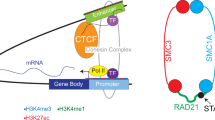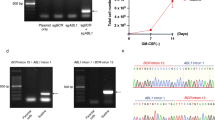Abstract
The MLL gene is frequently involved in chromosomal translocations associated with high-risk acute leukaemia. Infant and therapy-related acute leukaemia patients display chromosomal breakpoints preferentially clustered in the telomeric portion of the MLL breakpoint cluster region (SCII). Here, we demonstrate that SCII colocalizes with a gene-internal promoter element in the mouse and human MLL gene, respectively. The mRNA generated encodes an N-terminally truncated version of MLL that still exhibits many functional regions, including the C-terminal SET-domain. Etoposide-induced DNA double-strand breaks colocalize with the binding site of RNA polymerase II and the transcription initiation region, but not with a nearby Topo II consensus sequence. Thus, the observed genomic instability of the human MLL gene is presumably linked to transcriptional processes. The consequences of this novel finding for the creation of chromosomal translocations, the biology of the MLL protein and for MLL-mediated acute leukaemia are discussed.
This is a preview of subscription content, access via your institution
Access options
Subscribe to this journal
Receive 50 print issues and online access
$259.00 per year
only $5.18 per issue
Buy this article
- Purchase on Springer Link
- Instant access to full article PDF
Prices may be subject to local taxes which are calculated during checkout








Similar content being viewed by others
References
Andersen MK, Christiansen DH, Jensen BA, Ernst P, Hauge G, Pedersen-Bjergaard J . (2001). Therapy-related acute lymphoblastic leukaemia with MLL rearrangements following DNA topoisomerase II inhibitors, an increasing problem: report on two new cases and review of the literature since 1992. Brit J Haematol 114: 539–543.
Aplan PD, Chervinsky DS, Stanulla M, Burhans WC . (1996). Site-specific DNA cleavage within the MLL breakpoint cluster region induced by topoisomerase II inhibitors. Blood 87: 2649–2658.
Betti CJ, Villalobos MJ, Diaz MO, Vaughan AT . (2001). Apoptotic triggers initiate translocations within the MLL gene involving the nonhomologous end joining repair system. Cancer Res 61: 4550–4555.
Betti CJ, Villalobos MJ, Jiang Q, Cline E, Diaz MO, Loredo G et al. (2005). Cleavage of the MLL gene by activators of apoptosis is independent of topoisomerase II activity. Leukemia 19: 2289–2295.
Blackwell TK, Moore MW, Yancopoulos GD, Suh H, Lutzker S, Selsing E et al. (1986). Recombination between immunoglobulin variable region gene segments is enhanced by transcription. Nature 324: 585–589.
Broeker PL, Super HG, Thirman MJ, Pomykala H, Yonebayashi Y, Tanabe S et al. (1996). Distribution of 11q23 breakpoints within the MLL breakpoint cluster region in de novo acute leukemia and in treatment-related acute myeloid leukemia: correlation with scaffold attachment regions and topoisomerase II consensus binding sites. Blood 87: 1912–1922.
Calin GA, Sevignani C, Dumitru CD, Hyslop T, Noch E, Yendamuri S et al. (2004). MicroRNA profiling reveals distinct signatures in B cell chronic lymphocytic leukemias. Proc Natl Acad Sci USA 101: 2999–3004.
Felix CA, Walker AH, Lange BJ, Williams TM, Winick NJ, Cheung NK et al. (1998). Association of CYP3A4 genotype with treatment-related leukemia. Proc Natl Acad Sci USA 95: 13176–13181.
Gillert E, Leis T, Repp R, Reichel M, Hösch A, Breitenlohner I et al. (1999). A DNA damage repair mechanism is involved in the origin of chromosomal translocations t(4;11) in primary leukemic cells. Oncogene 18: 4663–4671.
Goto H, Shimazaki C, Tatsumi T, Yamagata N, Inaba T, Fujita N et al. (1994). Acute myelomonocytic leukemia after treatment with chronic oral etoposide: are MLL and LTG9 genes targets for etoposide? Int J Hematol 60: 145–149.
Hsieh JJ, Cheng EH, Korsmeyer SJ . (2003). Taspase1: a threonine aspartase required for cleavage of MLL and proper HOX gene expression. Cell 115: 293–303.
Khobta A, Carlo-Stella C, Capranico G . (2004). Specific histone patterns and acetylase/deacetylase activity at the breakpoint-cluster region of the human MLL gene. Cancer Res 64: 2656–2662.
Libura J, Slater DJ, Felix CA, Richardson C . (2005). Therapy-related acute myeloid leukemia-like MLL rearrangements are induced by etoposide in primary human CD34+ cells and remain stable after clonal expansion. Blood 105: 2124–2131.
Margueron R, Trojer P, Reinberg D . (2005). The key to development: interpreting the histone code? Curr Opin Genet Dev 15: 163–176.
Mitterbauer-Hohendanner G, Mannhalter C . (2004). The biological and clinical significance of MLL abnormalities in haematological malignancies. Eur J Clin Invest 34: 12–24.
Nakamura T, Mori T, Tada S, Krajewski W, Rozovskaia T, Wassell R et al. (2002). ALL-1 is a histone methyltransferase that assembles a supercomplex of proteins involved in transcriptional regulation. Mol Cell 10: 1119–1128.
Nasr F, Macintyre E, Venuat AM, Bayle C, Carde P, Ribrag V . (1997). Translocation t(4;11)(q21;q23) and MLL gene rearrangement in acute lymphoblastic leukemia secondary to anti topoisomerase II anticancer agents. Leuk Lymphoma 25: 399–401.
Quandt K, Frech K, Karas H, Wingender E, Werner T . (1995). MatInd and MatInspector: new fast and versatile tools for detection of consensus matches in nucleotide sequence data. Nucl Acids Res 23: 4878–4884.
Rabbitts TH . (1994). Chromosomal translocations in human cancer. Nature 372: 143–149.
Reichel M, Gillert E, Angermüller S, Hensel JP, Heidel F, Lode M et al. (2001). Biased distribution of chromosomal breakpoints involving the MLL gene in infants versus children and adults with t(4;11) ALL. Oncogene 20: 2900–2907.
Reichel M, Gillert E, Nilson I, Siegler G, Greil J, Fey GH et al. (1998). Fine structure of translocation breakpoints in leukemic blasts with chromosomal translocation t(4;11): the DNA damage-repair model of translocation. Oncogene 17: 3035–3044.
Richardson C, Jasin M . (2000). Frequent chromosomal translocations induced by DNA double-strand breaks. Nature 405: 697–700.
Sim SP, Liu LF . (2001). Nucleolytic cleavage of the mixed lineage leukemia breakpoint cluster region during apoptosis. J Biol Chem 276: 31590–31595.
Stanulla M, Wang J, Chervinsky DS, Thandla S, Aplan PD . (1997). DNA cleavage within the MLL breakpoint cluster region is a specific event which occurs as part of higher-order chromatin fragmentation during the initial stages of apoptosis. Mol Cell Biol 17: 4070–4079.
Strissel PL, Strick R, Rowley JD, Zeleznik-Le NJ . (1998). An in vivo topoisomerase II cleavage site and a DNase I hypersensitive site colocalize near exon 9 in the MLL breakpoint cluster region. Blood 92: 3793–3803.
Uhl J, Klan N, Rose M, Entian KD, Werz O, Steinhilber D . (2002). The 5-lipoxygenase promoter is regulated by DNA methylation. J Biol Chem 277: 4374–4379.
Yokoyama A, Kitabayashi I, Ayton PM, Cleary ML, Ohki M . (2002). Leukemia proto-oncoprotein MLL is proteolytically processed into 2 fragments with opposite transcriptional properties. Blood 100: 3710–3718.
Yu BD, Hess JL, Horning SE, Brown GA, Korsmeyer SJ . (1995). Altered Hox expression and segmental identity in Mll-mutant mice. Nature 378: 505–508.
Acknowledgements
We thank Jay Hess for providing the murine MLL wild-type and knockout fibroblast cell lines, and Tatsuya Nakamura and Eli Canaani (Philadelphia, USA) for providing the polyclonal antiserum PAS173. The MAB E3 was a gift from Robert Slany (Erlangen, Germany). We also thank Michael Karas, Martin Stanulla and Malek Djabali for critically reading the manuscript, and Ludger Klein-Hitpass for performing the Affymetrix experiments. This study was supported by research grants N1KR-S12T13 from the BMBF, Ma1876/5-2 and Ma1876/7-1 from the DFG to R.M.
Author information
Authors and Affiliations
Corresponding author
Rights and permissions
About this article
Cite this article
Scharf, S., Zech, J., Bursen, A. et al. Transcription linked to recombination: a gene-internal promoter coincides with the recombination hot spot II of the human MLL gene. Oncogene 26, 1361–1371 (2007). https://doi.org/10.1038/sj.onc.1209948
Received:
Revised:
Accepted:
Published:
Issue Date:
DOI: https://doi.org/10.1038/sj.onc.1209948
Keywords
This article is cited by
-
The KMT2A recombinome of acute leukemias in 2023
Leukemia (2023)
-
t(11;16)(q23;p13)/KMT2A-CREBBP in hematologic malignancies: presumptive evidence of myelodysplasia or therapy-related neoplasm?
Annals of Hematology (2020)
-
Base excision repair proteins couple activation-induced cytidine deaminase and endonuclease G during replication stress-induced MLL destabilization
Leukemia (2018)
-
The MLL recombinome of acute leukemias in 2017
Leukemia (2018)
-
Topoisomerase-mediated chromosomal break repair: an emerging player in many games
Nature Reviews Cancer (2015)



